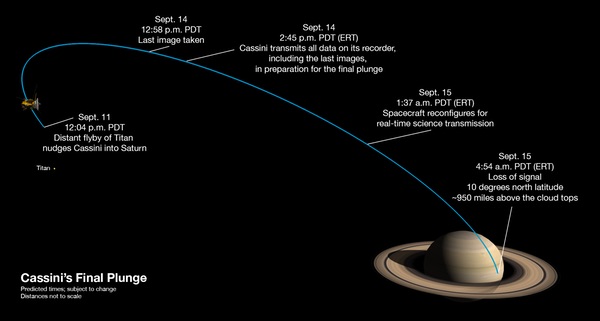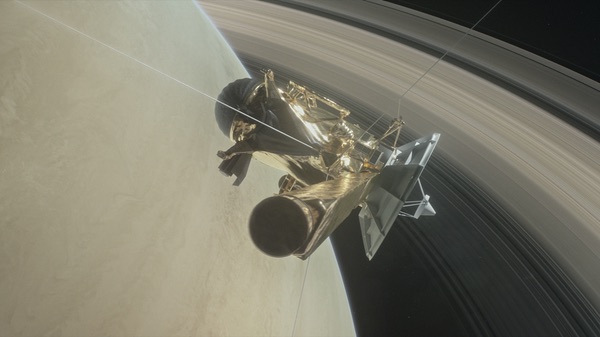Cassini’s grand finaleby Jeff Foust
|
| Maize called that flyby Cassini’s “final kiss” with Titan, then added, almost apologetically, “I don’t want to get too romantic about it, but that really is our last flyby.” |
This final phase of the mission started earlier this year with a series of passes that, for the first time, took Cassini inside the ring plane, through the narrow gap between the innermost ring and the planet’s upper atmosphere. Subsequent passes have brought the spacecraft ever closer to the planet.
“We would have never done this at any other time of the mission,” said Earl Maize, Cassini project manager at JPL, in a media teleconference last week. “There’s just so many uncertainties in this environment.”
During the first of those passes, Cassini oriented itself so that its large antenna served as a shield from any dust from the planet’s rings. “We were not quite certain that we were going to survive,” he said. “As it turned out, the dust that we thought was there is remarkably missing.”
Cassini has also lucked out on later passes that have dipped into the uppermost regions of the atmosphere. Had the atmosphere been thicker than expected at those altitudes, he said, the spacecraft could have spun out of control; had it been thinner, the spacecraft’s instruments would have been unable to collect data on atmospheric conditions. “We are in the Goldilocks zone. We have hit the perfect spot,” he said, eliminating the need for any so-called “contingency maneuvers” to raise or lower the spacecraft’s orbit.
Cassini is now entering its endgame. A final flyby of Titan on September 11 will put the spacecraft on a trajectory that will send it into Saturn in the early morning hours (California time) of September 15. Maize called that flyby Cassini’s “final kiss” with Titan, then added, almost apologetically, “I don’t want to get too romantic about it, but that really is our last flyby.”
After Cassini returns the data from that final Titan flyby, the spacecraft will conduct what he called the “last picture show”: a final set of images of the Saturn system, which will be returned to Earth by September 14, less than 24 hours before the end of the mission.
“These final images are sort of like taking a last look around your house or apartment just before you move out,” said Linda Spilker, Cassini project scientist. “Memories across the years come flooding back.”
“In the same way, Cassini is taking a last look around the Saturn system, Cassini’s home for the last 13 years,” she said. “With those pictures come heartwarming memories.”
| “The mission has exceeded all of our expectations,” Niebur said. “It’s done better than we could have ever dreamed.” |
In Cassini’s final hours, after the images from that last picture show have been returned, the spacecraft will become an atmospheric probe, transmitting data in real time. “The focus is going to be using all of our instruments to sample the atmosphere of Saturn,” she said. “We stand to get fundamental insights into Saturn’s formation and evolution, as well as the processes that occur in the atmosphere.”
As the plunge continues, atmospheric forces will tug on the spacecraft to the point where the thrusters, expending their final kilograms of fuel, cannot compensate. Mission planners expect to receive the final signals from Cassini on Earth a little before 5 a.m. Pacific time September 15. Cassini’s mission will be over.
 An illustration of the final days of Cassini’s mission at Saturn. (credit: NASA/JPL-Caltech) |
That mission dates back not just to Cassini’s arrival at Saturn in 2004, or its launch in 1997, but to its origins in the mid-1980s. At the time, it was conceived as the first of a series of missions called Mariner Mark II. The idea was to use a similar spacecraft bus, adapted with different instruments, to fly to different destinations in the outer solar system, saving money over doing such missions as one-off endeavors.
Cassini, though, turned into a one-off design. Its sibling, the Comet Rendezvous and Asteroid Flyby, or CRAF, mission was cancelled in the early 1990s as part of agency budget cuts, and no other missions using the Mariner Mark II bus got off the drawing boards. Cassini itself faced some near-death experiences during its development before it finally lifted off the pad on a Titan IV in 1997.
At the briefing, project officials went to great lengths to explain how much Cassini had accomplished with technology that dated back to the 1980s. “Desktop computers were exactly that: they covered your entire desk,” recalled Curt Niebur, Cassini program scientist at NASA headquarters. “Streaming video meant that your VCR was broken and spitting out magnetic tape into a tangled pile on the floor.”
Maize stayed away from those colorful analogies when he emphasized what the spacecraft had done. “Our computer stats might be a little modest by today’s standards,” he said. “But remember, we were using 1980s technology, so 635 gigabytes in 1987 was pretty tall cotton.”
Those 635 gigabytes have transformed our understanding of Saturn and its moons. “The mission has exceeded all of our expectations,” Niebur said. “It’s done better than we could have ever dreamed. The Saturn system is absolutely chock full of amazing worlds of all sizes, and Cassini has been exploring them for the past 13 years.”
Perhaps the most amazing world has turned out to be Enceladus. The small moon, to the surprise of scientists, turns out to have an icy crust with an ocean of liquid water underneath, with geysers regularly erupting from its surface. Despite all the attention focused on Europa, the much larger icy moon of Jupiter, some scientists speculate that Enceladus could be just as habitable, and perhaps even more accessible to future probes.
“Enceladus has no business existing, and yet there it is, practically screaming at us, ‘Look at me! I completely invalidate all of your assumptions about the solar system,’” Niebur said. “It’s just been a remarkable opportunity to study Enceladus and to unveil the secrets that it’s been keeping. It’s an amazing destination.”
Enceladus and Titan—which, Cassini has found, has seas of hydrocarbons on its surface—have helped reshape our views of the solar system and the potential for life. Those worlds, along with Europa, have led to the concept of “ocean worlds” that has become a focus of study for NASA. They are becoming more promising places to look for life than Mars, which has dominated scientists’ and NASA’s attention for the past two decades.
Right now, though, there is no mission on the books to return to Saturn and its moons. That could change in a couple of years: both a “Saturn Probe” and ocean worlds missions to Titan and/or Enceladus are among the options for NASA’s next New Frontiers medium-class planetary science mission. NASA accepted proposals for that mission earlier this year and is expected to announce a set of finalists this fall that will win funding for additional study, leading to a final decision in 2019 for launch by the mid-2020s. But even if a Saturn mission wins the New Frontiers competition, it may not arrive there until after 2030.
| “Cassini has been a great mission. We’ve planned its end… So it’s time,” said Spilker. |
Spilker would like to see some kind of mission return to Saturn. “I think we’ve learned so much about the Saturn system that, if I could create a new mission, I’d want to go back,” she said. “I’d want to go back and explore and try to answer the questions about Enceladus’ oceans, also carry some experiments to further explore Titan, maybe a Saturn probe.”
She added she wished that Cassini—in good health other than its depleted fuel reserves—could operate even longer. “If we had more fuel, perhaps another ten years at Saturn would be just about right,” she said.
But, later in the teleconference, she acknowledged that perhaps now was the right time for Cassini to come to an end. “I feel a tremendous sense of pride in all that Cassini has accomplished,” she said. “In so many ways, we’ve really rewritten the textbooks on Saturn’s system.”
“Cassini has been a great mission. We’ve planned its end. We had its fuel last exactly the amount of time needed to get through Saturn’s summer solstice. So it’s time. It’s time to take our knowledge and our information and move that out into future missions, to the outer planets and beyond.”
